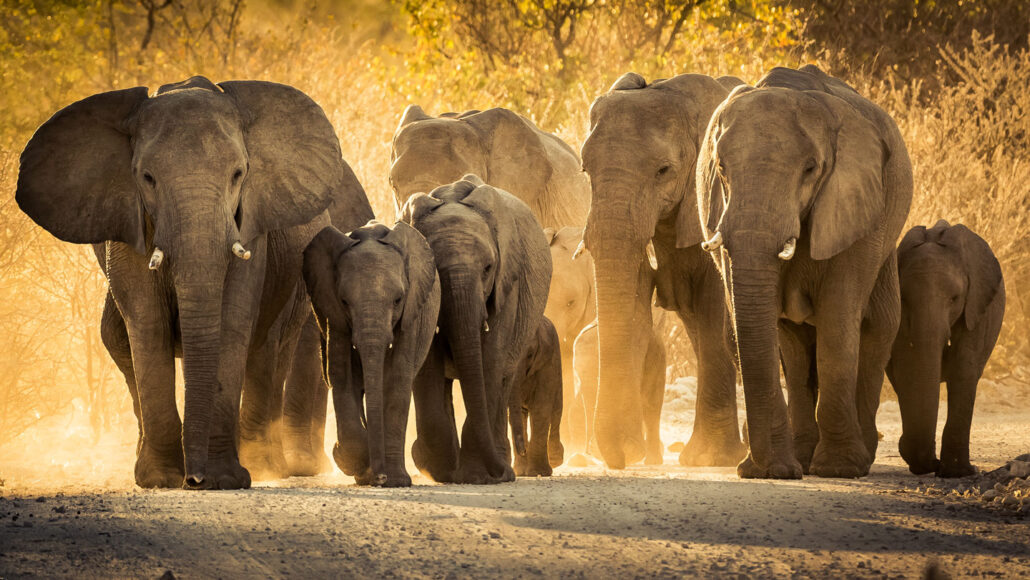Let’s learn about elephants
These animals are pretty remarkable, from their bizarre sleeping habits to their infrasonic songs

While female elephants are social creatures that live in herds of relatives, males usually live alone or in small groups of males.
Claudio Braslavsky/500px/Getty Images
Elephants are gentle giants. The largest mammals on land, these creatures include three different species. One is the Asian forest elephant. Two more live in Africa: the African savanna elephant and African forest elephant.
The three species differ in more than geography. African elephants have bigger ears than their Asian relatives. Both male and female African elephants sport tusks. Only some male Asian elephants do. African savanna elephants weigh some four to seven tons. African forest elephants, on the other hand, weigh two to five tons.
Elephants were once common across Africa and Asia. But their numbers have plummeted over the last century. Asian elephants face severe habitat loss due to human expansion. And the vast majority of African elephants have been wiped out by poachers who sell the ivory tusks.
But elephants are remarkable for much more than their ivory. They capture the public imagination with their complex social structures and extremely nimble trunks. And scientists are learning curious new details about these creatures all the time. Check out five wild facts about this amazing animal.
The trunk is one powerful appendage.
Elephants are known to use their trunks to vacuum up food and shower themselves with water. But scientists were blown away to discover just how fast air and water can move through an elephant’s snoot. Elephants can blow air through their trunks at hundreds of miles per hour. What’s more, water can flow through an elephant’s trunk at about 3.7 liters (1 gallon) of water per second. That rivals the flow of about 24 shower heads.
Elephants sing infrasonic songs.
Elephants don’t just trumpet. They also “sing” notes so deep they can’t be heard by the human ear. Such low frequencies, below 20 Hertz, are known as infrasonic notes. This low rumble can travel as far as 10 kilometers (6.6 miles) through the air and even farther through the ground. This allows elephants to communicate over long distances.
For such big animals, elephants may be lightweights.
Tales of elephants eating fermented fruit to get tipsy date back centuries. Scientists were long suspicious of those stories. After all, how could an elephant eat enough fruit to get drunk? But it turns out that elephants may be especially bad at handling their booze. That’s because elephants have a genetic mutation that may make it hard for their bodies to break down alcohol.
No sleep, no problem for elephants.
These creatures hold the record for shortest amount of sleep among mammals. Elephants get a mere two hours of shut-eye per night. They can also skip a night’s sleep without needing to nap the next day. Elephants typically snooze while standing up and only lie down every few nights. These animals may be especially restless because they must be on high alert for poachers. Elephants in captivity sleep even longer.
Elephants are super-sniffers.
Elephants aren’t only record-holders because of their bizarre sleep schedules. They also have the most scent-detecting genes of any animal. Elephants boast some 2,000 genes for picking up odors. Bloodhounds have just 800 scent-sensing genes. Humans have a measly 40. Elephants’ sense of smell is so good that they can distinguish between different quantities of seeds that would be hard to tell apart just by looking.
Want to know more? We’ve got some stories to get you started:
Elephants’ trunks: These leaf-blowers snag food Elephants can use their trunks like leaf-blowers to push food toward them with puffs of air. (12/6/2015) Readability: 7.4
How do elephants eat cereal? With a pinch Elephants use their trunks to grab everything from whole trees to bits of cereal. To pick up small snacks, they press, then pinch their trunks. Knowing how elephants nimbly pick up food could inspire new designs for flexible robots. (12/7/2018) Readability: 6.9
DNA in ivory pinpoints elephant poaching hot spots Many elephants have been killed for their ivory tusks. One study used DNA in ivory to trace where most of the killings happened. The researchers traced illegal ivory trade to two African regions. (7/2/2015) Readability: 8.0
Explore more
Activities
Eager to see elephants in action? Check out the San Diego Zoo Safari Park’s live elephant cam. The video feed keeps tabs on the eight-elephant herd for 12 hours a day.
Still curious? Embark on this scavenger hunt for more fun elephant facts. The answers can all be found in stories linked in this article.
- For a long time, scientists thought elephants’ infrasonic songs were similar to another familiar animal sound. What sound was that?
- How many times faster than a human sneeze can an elephant blow air through its trunk?
- Elephants aren’t the only lightweights of the animal kingdom. What other creatures may easily get drunk?
- It’s hard to tell if an elephant is asleep just by looking at it, especially in the dark. How did some researchers in southern Africa monitor elephants’ sleep habits?
- Some African elephants’ sense of smell is so good they can distinguish between different ethnic groups of people. Why might that be useful?







